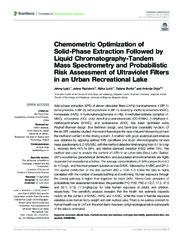Приказ основних података о документу
Chemometric Optimization of Solid-Phase Extraction Followed by Liquid Chromatography-Tandem Mass Spectrometry and Probabilistic Risk Assessment of Ultraviolet Filters in an Urban Recreational Lake
| dc.creator | Lukić, Jelena | |
| dc.creator | Radulović, Jelena | |
| dc.creator | Lučić, Milica | |
| dc.creator | Đurkić, Tatjana | |
| dc.creator | Onjia, Antonije | |
| dc.date.accessioned | 2022-09-08T10:45:14Z | |
| dc.date.available | 2022-09-08T10:45:14Z | |
| dc.date.issued | 2022 | |
| dc.identifier.issn | 2296-665X | |
| dc.identifier.uri | http://TechnoRep.tmf.bg.ac.rs/handle/123456789/5181 | |
| dc.description.abstract | Solid-phase extraction (SPE) of eleven ultraviolet filters (UVFs): benzophenone-1 (BP-1); benzophenone-3 (BP-3); benzophenone-4 (BP-4); isoamyl p-methoxycinnamate (IAMC), homosalate (HMS); 4-hydroxybenzophenone (4-HB); 4-methylbenzylidene camphor (4-MBC); octocrylene (OC); octyl dimethyl-p-aminobenzoate (OD-PABA); 2-ethylhexyl-4-methoxycinnamate (EHMC); and avobenzone (AVO), has been optimized using Plackett-Burman design, Box-Behnken design, and Derrindzer desirability function. Of the six SPE variables studied, the most influencing is the type of eluent followed by pH and the methanol content in the rinsing solvent. A method with good analytical performance was obtained by applying optimal SPE conditions and liquid chromatography-tandem mass spectrometry (LC-MS/MS), with the method detection limit ranging from 0.1 to 5 ng/L, recovery from 44% to 99%, and relative standard deviation (RSD) within 19%. This method was used to analyze the content of UVFs in an urban lake (Sava Lake, Serbia). UVFs occurrence, geostatistical distribution, and associated environmental risk are highly dependent on recreational activities. The average concentrations of UVFs ranged from 0.3 to 113 ng/L, and the most present substance was EHMC, followed by 4-MBC and BP-3. The spatial distribution of the risk quotient (RQ = 0.04–1.7) inside the lake is highly correlated with the number of people bathing and swimming. Human exposure through the dermal pathway is higher than ingestion for most UVFs. Monte Carlo simulation of probabilistic risk assessment estimated the percentile P10, P50, P90 of 12.7; 17.3; 47.5 and 20.1; 27.6; 77.5 ng/kg∙day for total human exposure of adults and children, respectively. The sensitivity analysis revealed that the health risk estimate depends mostly on the content of EHMC, HMS, and 4-MBC, while the most influential exposure variables were human body weight and skin surface area. There is no serious concern to human health due to UVFs in the short term; however, a high ecological risk in some parts of the lake is estimated. | sr |
| dc.language.iso | en | sr |
| dc.publisher | Frontiers Media S.A. | sr |
| dc.relation | info:eu-repo/grantAgreement/MESTD/inst-2020/200135/RS// | sr |
| dc.relation | info:eu-repo/grantAgreement/MESTD/inst-2020/200287/RS// | sr |
| dc.rights | openAccess | sr |
| dc.rights.uri | https://creativecommons.org/licenses/by/4.0/ | |
| dc.source | Frontiers in Environmental Science | sr |
| dc.subject | Box-Behnken | sr |
| dc.subject | Derringer desirability | sr |
| dc.subject | Monte Carlo | sr |
| dc.subject | Plackett-Burman | sr |
| dc.subject | risk quotient | sr |
| dc.subject | spatial distribution | sr |
| dc.subject | sunscreen | sr |
| dc.subject | SWIMODEL | sr |
| dc.title | Chemometric Optimization of Solid-Phase Extraction Followed by Liquid Chromatography-Tandem Mass Spectrometry and Probabilistic Risk Assessment of Ultraviolet Filters in an Urban Recreational Lake | sr |
| dc.type | article | sr |
| dc.rights.license | BY | sr |
| dc.citation.rank | M21~ | |
| dc.citation.spage | 916916 | |
| dc.citation.volume | 10 | |
| dc.identifier.doi | 10.3389/fenvs.2022.916916 | |
| dc.identifier.fulltext | http://TechnoRep.tmf.bg.ac.rs/bitstream/id/12763/bitstream_12763.pdf | |
| dc.identifier.scopus | 2-s2.0-85133882922 | |
| dc.identifier.wos | 00082181100000 | |
| dc.type.version | publishedVersion | sr |

